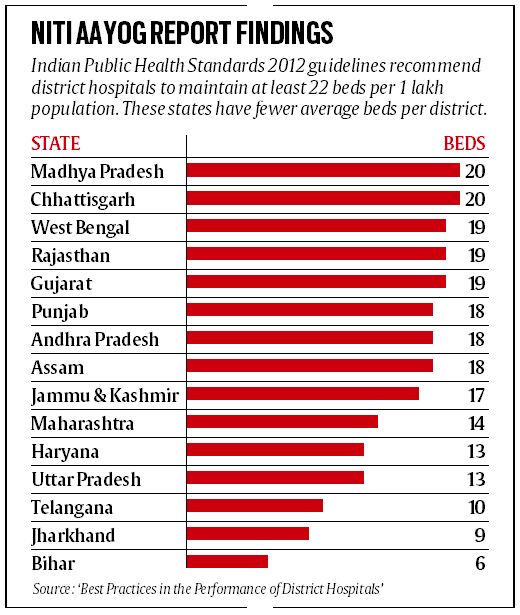A district hospital in India has on an average 24 beds per 1 lakh population, with Bihar having the lowest average of six beds and Puducherry the highest of 222, a study conducted by the government’s top think tank NITI Aayog has revealed.
The study – Best Practices in the Performance of District Hospitals – was released on Thursday.

“It is seen that on an average a district hospital in India has 24 beds per 1 lakh population. The Indian Public Health Standards (IPHS) 2012 guidelines recommend district hospitals to maintain at least 22 beds per 1 lakh population (based on district population average of 2001 Census),” states the report, prepared after an assessment of 707 hospitals across 36 states and Union Territories conducted in 2018–19.
Story continues below this ad
It further said, “District hospitals in India have a range of 1 to 408 beds per 1 lakh population. 217 district hospitals were found to have at least 22 beds for every 1 lakh population.”
The findings of the study are significant as it was conducted just before the outbreak of Covid-19. The findings mean that when the country faced the wrath of the pandemic, public health infrastructure, particularly at district level, was not adequate. This was experienced during the second wave of Covid-19, when the country’s health facilities were overwhelmed.

The NITI Aayog report also shows that in 15 states and UTs, the average number of beds in a district hospital was lower than 22 beds per 1 lakh population as recommended by the IPHS 2012 guidelines — Bihar (6), Jharkhand (9), Telangana (10), Uttar Pradesh (13), Haryana (13), Maharashtra (14), Jammu & Kashmir (17), Assam (18), Andhra Pradesh (18), Punjab (18), Gujarat (19), Rajasthan (19), West Bengal (19), Chhattisgarh (20) and Madhya Pradesh (20).
The average number of beds per lakh population in a district hospital was higher than the recommended figure of 22 beds per lakh of population across 21 states and Uts–– Puducherry (222), A & N Islands (200), Ladakh (150), Arunachal Pradesh (102), Daman & Diu (102), Lakshadweep (78), Sikkim (70), Mizoram (63), Delhi (59), Chandigarh (57), Meghalaya (52), Nagaland (49), Himachal Pradesh (46), Karnataka (33), Goa (32), Tripura (30), Manipur (24), Uttarakhand (24), Kerala (22), Odisha (22) and Tamil Nadu ( 22).
Story continues below this ad
The report was launched in the presence of NITI Aayog Member Dr VK Paul, CEO Amitabh Kant, WHO Representative to India Dr Roderico Ofrin and other senior officials.
“Overall, 75 district hospitals across 24 States and Union Territories emerged as top performers on indicators ranging from availability of beds, medical and paramedical staff, core health and diagnostic testing services to outputs such as bed occupancy rate and number of surgeries per surgeon,” the statement said.










